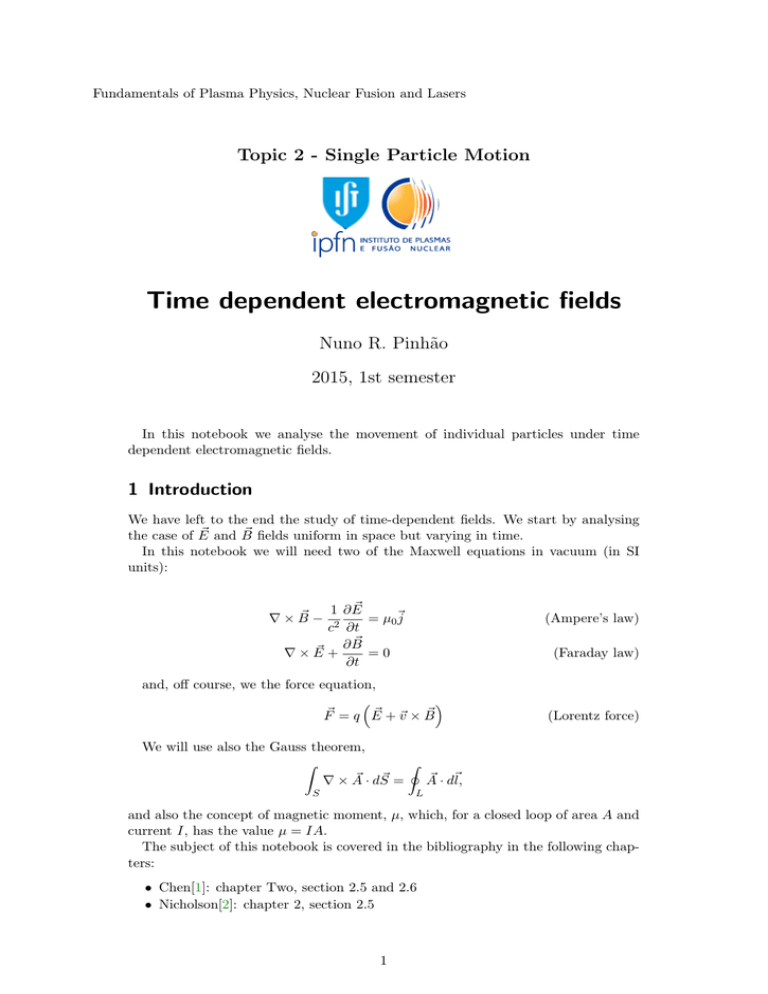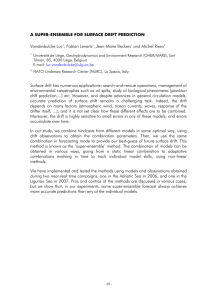Time dependent electromagnetic fields
advertisement

Fundamentals of Plasma Physics, Nuclear Fusion and Lasers
Topic 2 - Single Particle Motion
Time dependent electromagnetic fields
Nuno R. Pinhão
2015, 1st semester
In this notebook we analyse the movement of individual particles under time
dependent electromagnetic fields.
1 Introduction
We have left to the end the study of time-dependent fields. We start by analysing
~ and B
~ fields uniform in space but varying in time.
the case of E
In this notebook we will need two of the Maxwell equations in vacuum (in SI
units):
~
1 ∂E
= µ0~j
2
c ∂t
~
~ + ∂B = 0
∇×E
∂t
~−
∇×B
(Ampere’s law)
(Faraday law)
and, off course, we the force equation,
~ + ~v × B
~
F~ = q E
(Lorentz force)
We will use also the Gauss theorem,
Z
I
~
~
~ · d~l,
∇ × A · dS =
A
S
L
and also the concept of magnetic moment, µ, which, for a closed loop of area A and
current I, has the value µ = IA.
The subject of this notebook is covered in the bibliography in the following chapters:
• Chen[1]: chapter Two, section 2.5 and 2.6
• Nicholson[2]: chapter 2, section 2.5
1
• Bittencourt[3]: chapter 4
• Goldston[4]: chapter 4
The examples are prepared with the help of two scientific software packages,
Scipy[5] and IPython[6].
~
2 Time-dependent electric field, E(t)
~ varies in time. What do we
We start by considering the case in which only E
expect to happen?
~ ×B
~ drift only that in this case vd changes with E(t).
~
• We should still have a E
I.e. there is a force in vd direction. Together with the magnetic field, this force
~ ×B
~ drift and
induces also a drift but in the direction perpendicular to the E
~ ! Contrarily to this drift where the direction does not
in the direction of E
depends on q, this new component of the drift depends on q and the drift of
positive and negative charges creates a current. We will call it polarization
drift.
Let’s try to find out the expression for this drift. To simplify we considere that
~
~ along the x axis:
E(t)
varies in time with a sinusoidal function. Let’s take E
~ = E0 exp(iωt)~ux .
E
From the Lorentz force equation we have
E˙x (t)
B
E
x (t)
v̈y = −ωc2 vy − ωc2
B
v̈x = −ωc2 vx ± ωc
(1)
(2)
with E˙x = iωEx and defining
iω Ex
ωc B
Ex
vE = − ,
B
vp = ±
(+)
(3)
the above equations become
v̈x = −ωc2 (vx − vp )
(4)
−ωc2 (vy
(5)
v̈y =
− vE )
We can guess that the solution is a sum of a gyratory and a drift. As such we can
try the following system:
vx = v⊥ eiωc t + vp
vy = ±iv⊥ e
iωc t
+ vE
If we differenciate that system of functions, what we get is
2
(6)
(7)
v̈x = −ωc2 vx + (ωc2 − ω 2 )vp
(8)
v̈y = −ωc2 vy + (ωc2 − ω 2 )vE ,
(9)
~ varies slowly in
which is not the correct solution unless ω ωc , i.e. the field E
comparison with the cyclotronic movement.
~ and write
We can generalize the equation (+) for an arbitrary variation of E
~vp = ±
~
1 dE
ωc B dt
~ ×B
~ drift oscillates with a frequency ω.
Note: The E
2.1 Plasma dielectric constant
This drift produces a polarization current density:
~
~
~j = n0 q(~vi − ~ve ) = n (mi + me ) E⊥ = ρm dE⊥ ,
B2
dt
B 2 dt
with ρm the plasma mass density. This polarization current can be taken into
account through a dielectric constant of the plasma. We can include this polarization
current in Ampere’s law. Combining with the E-field term,
~
~⊥
~⊥
ρm ∂ E
1
ρm
∂ E⊥
1 ∂E
+ µ0 2
= 2 1+
2
2
c ∂t
B ∂t
c
0 B
∂t
and we define a effective electric permittivity perpendicular to the magnetic field as
ρm
.
= 0 r = 0 1 +
0 B 2
2.2 Practice:
Let’s see the actual movement. The base program is the same as we have been
using and only the description of fields changes. In this case we use a field linearly
~
dependent on t, E(t)
= E0 t/α.
We have also included (as a comment line) a sinusoidal field with a frequency
proportional to the ωc . It is interesting to explore the results with this function for
different values of α.
In [6]: %matplotlib inline
import numpy as np
from trajectories import *
In [7]: def polarizE(Q, t, qbym, E0, B0, keywords):
"""Equations of movement for a time dependent electric field
perpendicular to B."""
wc = "wc" in keywords.keys() and keywords["wc"] or 0
alpha = "dump" in keywords.keys() and keywords["dump"] or 1
v = Q[3:]
# Velocity
dvdt = qbym*(E0*t/alpha + np.cross(v,B0)) # Acceleration
#dvdt = qbym*(E0*np.sin(t*wc/alpha) + np.cross(v,B0)) # Acceleration
3
return np.concatenate((v,dvdt))
def polarizDift(alpha=371):
"""Movement with a time dependent E field perpendicular to B"""
E0 = np.array([1,0,0])
# The E field is E0*cos(w*t)\vec{u}_x
we = q*B0[2]/me; wp = q*B0[2]/Mp
# Cyclotron frequencies
re, rp = computeTrajectories(polarizE, E0, wc=[we,wp], dump=alpha)
plotPolariz(re,rp)
polarizDift()
~
3 Time-dependent magnetic field, B(t)
From the Faraday law we see that a time-varying magnetic field is accompanied by
a space-varying electric field.
~
We need to assume again small changes, i.e. that the fractional change in B(t)
is small in a time interval on the order of cyclotron period. We take the magnetic
field along z, spatially uniform and increasing. As a result of the accompanying
electric field the orbit is no longer circular. It will, however, be “quasi”-circular,
~ small. In cylindrical coordinates and in this case,
the azimuthal component of E
Faraday equation is
∂B
1 ∂
(rEθ ) = −
r ∂r
∂t
Integrating in r (assuming B a slow function), we obtain
1 ∂B
Eθ = − r
2 ∂t
4
which can be written as
~
~ θ = 1 ~r × ∂ B
E
2
∂t
We could use these results in the Lorentz force to obtain the equations of movemente
but we will use an alternative path:
Taking the scalar product of the Lorentz force equation with v⊥ , and integrating
in one gyration period, we have the change in the kinetic energy in the period,
I
1
2
~ θ · d~r
δ( mv⊥ ) = q E
2
Considering the orbit (almost) close, using Stokes’s theorem, we can replace the line
integral by a surface integral,
1
2
δ( mv⊥
)=q
2
Z
~ θ ) · dS
~ = −q
(∇ × E
Z
S
S
~
∂B
~
· dS
∂t
~ for negative and positive charges, we
Taking account of the opposing direction of S
have
~
∂B
1
2
δ( mv⊥
) = |q|
πr2
2
∂t L
~
Using δB = (∂ B)/(∂t)(2π)/ω
c and the definitions of rL , ωc and µ we get to the
result
1
2
) = µδB
δ( mv⊥
2
2 ) = δ(µB), the previous result implies that δµ = 0 ! I.e. in slowly
and, as δ( 12 mv⊥
varying magnetic fields, the magnetic moment is invariant. This also implies
2 = cte:
that for the magnetic flux, BπrL
• the Larmor radius decreases as B increases.
• the magnetic flux is also an adiabatic invariant.
The conservation of µ also implies that
• the transverse kinetic energy, W⊥ increases linearly com B.
4 Summary
General force F~ :
~vd =
~
F~ × B
2
qB
• Electric field:
~vd =
• Gravitational field:
vg =
~ ×B
~
E
B2
~
m ~g × B
2
q B
~ field:
Non-uniform E
~
~
1 2 2 E
×B
~vE = 1 + rL ∇
.
4
B2
~ field:
Non-uniform B
5
• Grad-B drift:
~ × ∇B
1
B
~v∇B = ± v⊥ rL
2
B2
• Curvature drift:
~vcurv = ±
~ × ∇B
vk2 B
ωc
B2
– Curved vacuum field:
~vd =
1
mv 2 + mvk2
2 ⊥
~c × B
~
1 R
qB 2 Rc2
~ field:
Time-dependent E
• Polarization drift:
~vp = ±
~
1 dE
ωc B dt
References
[1] Francis Chen. Single-particle Motions, chapter 2, pages 19–52. Plenum, 1974.
[2] Dwight R. Nicholson. Single Particle Motion, chapter 2, pages 17–36. Wiley
series in plasma physics. John Wiley & Sons, 1983.
[3] J. A. Bittencourt. Charged particle motion in constant and uniform electromagnetic fields, chapter 2, 3, pages 33–89. Springer, 2004.
[4] R. L. Goldston and P. H. Rutherford. Single-particle Motion, pages 21–68. IOP
Publishing, Bristol and Philadelphia, 1995.
[5] Eric Jones, Travis Oliphant, Pearu Peterson, et al. SciPy: Open source scientific
tools for Python, 2001–. [Online].
[6] Fernando Pérez and Brian E. Granger. IPython: a system for interactive scientific computing. Computing in Science and Engineering, 9(3):21–29, May 2007.
6


